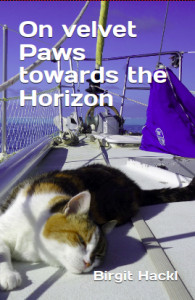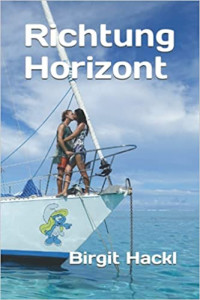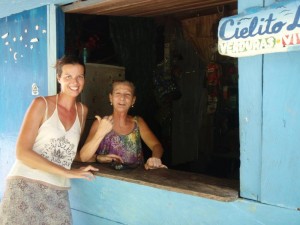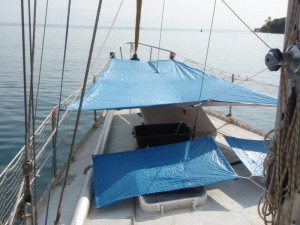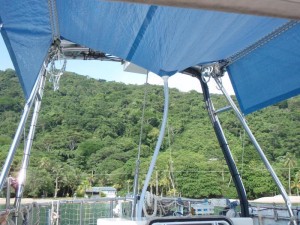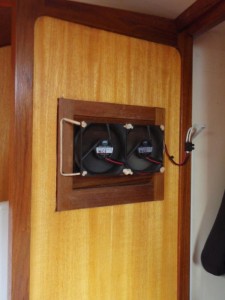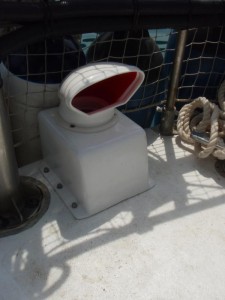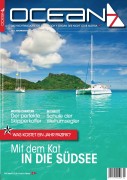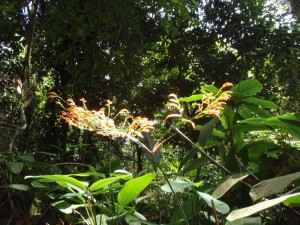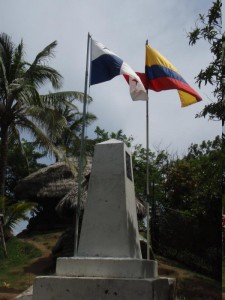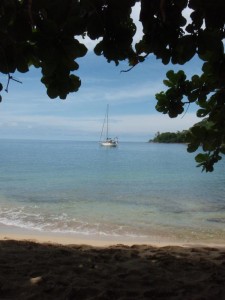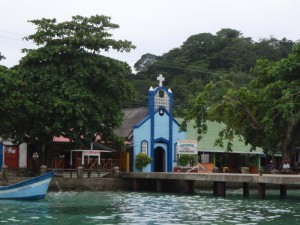Yesterday we got chatting with Kunas from the village Malatupu who come to Puerto Escoces to fish and harvest fruit and veggies from the gardens they have here. At the moment 3 men and 2 boys stay in one of the huts that are built on the reef. Instead of asking for presents and trying to sell us overpriced veggies (like the Kuna in Puerto Perme) they insisted on giving us a crab, some fish and plantains for free and invited us to have dinner with them the next day.
In the afternoon we packed some T-Shirts, fishing gear, a cake and cold beers and set out to visit our “amigos”. We were amazed to find several giant langostas (spiny lobsters) boiling over an open fire. Fortunately one of them speaks good Spanish so we asked him lots of questions about the Kuna lifestyle and found out that most of them aren’t as strictly traditional as expected, even though we’re still in the most remote, least visited and therefore most traditional part of Kuna Yala. They have an outboard engine, eat spicy food, etc. Felipe worked 3 years in a hotel in Panama City, but came back to his village where he’s his own boss. He saved some money, works hard in his gardens and dreams about opening an eco-lodge in Puerto Escoces. Apparently drug trafficking is still an issue, sometimes boats drop their powdery packages and for the Kuna who happens to pick it up it’s like winning in the lottery ![]()
+++++++++++++++++++++
Ein nobles Abendessen
Gestern sind wir mit ein paar Kunas vom Dorf Malatupu ins Reden gekommen, die nach Puerto Escoces kommen, um zu fischen und in ihren Gaerten Fruechte und Gemuese zu ernten. Im Moment bleiben 3 Maenner und 2 Jungs in einer der Huetten auf dem Riff. Anstatt uns nach Geschenken zu fragen und zu versuchen uns ueberteuertes Gemuese anzudrehen (wie die Kunas in Puerto Perme), bestanden sie darauf uns eine Krabbe, ein paar Fische und Platanen zu schenken und luden uns dann noch zum Abendessen am naechsten Tag ein.
Heute Nachmittag packten wir deshalb ein paar T-Shirts, Angelzeug, einen Kuchen und ein paar kalte Biere ein und besuchten unsere “amigos”. Zu unserer Ueberraschung kochten bereits mehrere riesige Langusten in einem Topf ueber dem offenen Feuer. Gluecklicherweise spricht einer von ihnen gutes Spanisch und somit loecherten wir ihn mit Fragen zum Leben der Kuna. Es stellte sich heraus, dass die meisten nicht so streng traditionell leben wie erwartet, obwohl wir hier immer noch im abgelegensten, am wenigsten besuchten uns somit traditionellsten Teil der Kuna Yala sind. Sie haben Aussenborder, wuerzen das Essen, etc. Felipe hat 3 Jahre in einem Hotel in Panama City gearbeitet, ist aber in sein Dorf zurueckgekommen, wo er sein eigener Chef sein kann. Er hat Geld gespart, arbeitet hart in seinen Gaerten und traeumt davon in Puerto Escoces eine Eco-Lodge zu errichten. Anscheinend sind an der Kueste immer noch genuegend Drogenboote unterwegs, manchmal verliert eins ein pudriges Paket, fuer den Kuna, der es findet ist das wie ein Gewinn in der Lotterie ![]()


